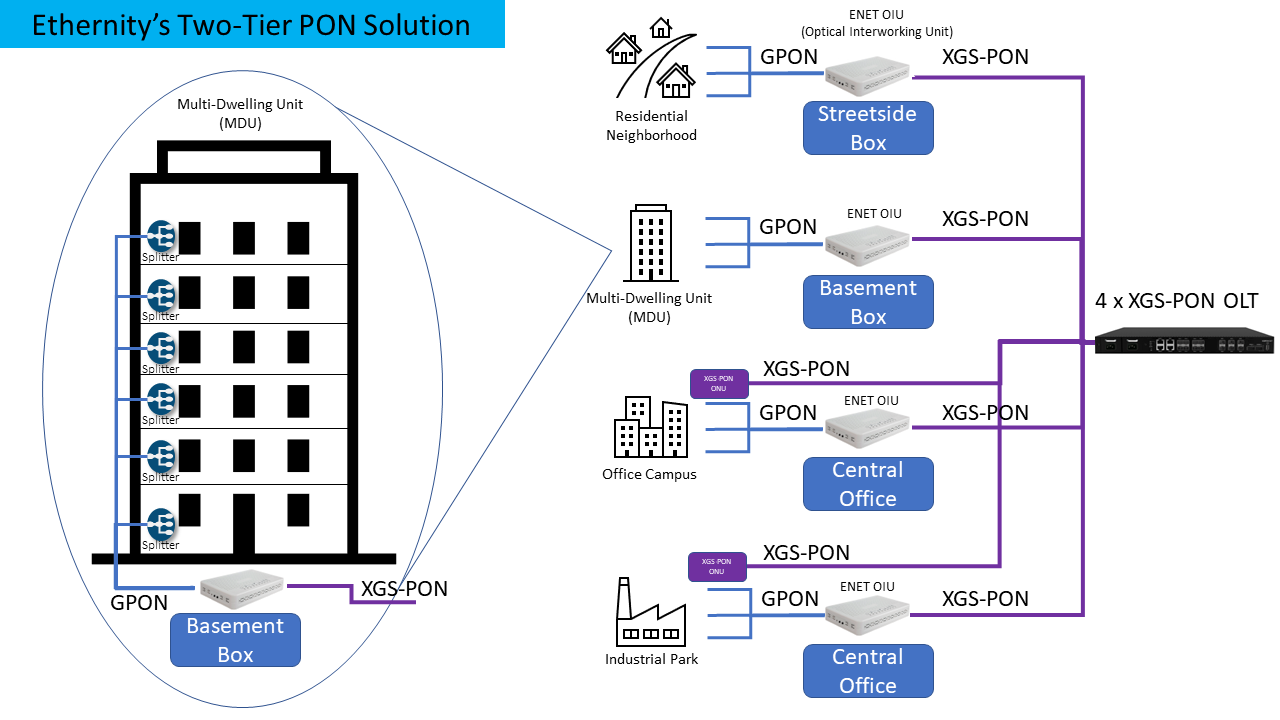The Market Need
The vast majority of today’s fiber access deployments are served by Gigabit PON (GPON), a passive optical transmission technology that uses a single fiber strand to connect up to 64 residential premises. While GPON currently provides sufficient bandwidth to the average residential consumer, larger residential areas and multi-tenant buildings require a large number of fiber optic ports to receive service from the central office. This can become prohibitively costly for the service provider.
As such, many service providers would like to begin using 10G PON (XGS-PON) to service such areas, as well as to industrial zones and for connectivity to 5G antennae. While XGS-PON’s much higher bandwidth is overkill for typical residential users at this point, its wider pipes can service more homes and businesses than can GPON.
However, XGS-PON uses different technology than GPON, and laying entirely new fiber networks is not an option for most service providers. Moreover, as 25G and 50G PON technologies become more ubiquitous, an approach that can also account for new technologies is required that will futureproof the existing deployments.
While the Combo PON (CPON) concept has gained some traction because it offers a means of supporting both GPON and XGS-PON through a single platform, it is extremely expensive and not economically viable for scaling to larger deployments.
Our Offering
Therefore, Ethernity Networks introduces its new Two-Tier PON Solution, which offers maximum flexibility, scalability, and economy for service providers who seek to service large residential areas, multi-tenant buildings, business campuses, and industrial complexes.
Two-Tier PON provides the higher throughput of XGS-PON (or higher) technology to greenfield deployments, while continuing to serve the majority of brownfield PON users with existing GPON infrastructure. This is achieved by way of an FPGA-based Optical Interworking Unit (OIU) that on one side serves as a GPON Optical Line Termination (OLT) and on the other side acts as a high-end XGS-PON Optical Networking Unit (ONU).
The OIU handles the two tiers of PON, seamlessly converting between the GPON and XGS-PON technologies, such that the wider XGS-PON pipes can now provide service for exponentially more GPON users. This provides the economies of scale that are necessary to justify XGS-PON deployment.
For example, while current GPON OLTs can only reach 64 end users, a single XGS-PON OLT can serve 64 OIUs, thereby providing GPON to over 4,000 end users. A four-port XGS-PON OLT could enable GPON service to 16,000 endpoints.
- Ideal for MDUs & Business Parks: Serves either XGS-PON or GPON to significantly more end users than existing solutions at a fraction of the infrastructure cost
- Extremely Flexible & Scalable: Enables XGS-PON to those who require higher throughput, while continuing to serve GPON to the majority of end users
- More Cost-Efficient Than CPON: Can reach up to 16,000 endpoints from a single comparatively inexpensive four-port XGS-PON OLT
- Ready for Future Technology: Accounts for 25G and 50G PON when they become ubiquitous in the industry
1GbE/10GbE Wireless Bonding


